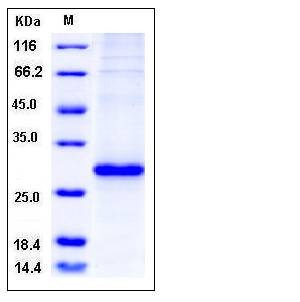Human RhoA Protein (His Tag)
ARH12,ARHA,RHO12,RHOH12
- 100ug (NPP4220) Please inquiry
| Catalog Number | P12441-H07B |
|---|---|
| Organism Species | Human |
| Host | Baculovirus-Insect Cells |
| Synonyms | ARH12,ARHA,RHO12,RHOH12 |
| Molecular Weight | The recombinant human RHOA consists of 212 amino acids and has a calculated molecular mass of 24 kDa. It migrates as an approximately 28 kDa band in SDS-PAGE under reducing conditions. |
| predicted N | Met |
| SDS-PAGE |  |
| Purity | > 90 % as determined by SDS-PAGE |
| Protein Construction | A DNA sequence encoding the human RHOA (P61586-1) (Met 1-Leu 193) was fused with a polyhistidine tag at the N-terminus. |
| Bio-activity | |
| Research Area | Neuroscience |Cell Adhesion Proteins |Cytoskeletal Proteins |Microfilaments |Actin etc |Actin Assembly | |
| Formulation | Lyophilized from sterile 20mM Tris, 500mM NaCl, pH 7.4, 10% glycerol 1. Normally 5 % - 8 % trehalose, mannitol and 0.01% Tween80 are added as protectants before lyophilization. Specific concentrations are included in the hardcopy of COA. |
| Background | Transforming protein RhoA, also known as Rho cDNA clone 12, Ras homolog gene family member A, RHOA and ARH12, is a cell membrane and cytoplasm protein which belongs to the small GTPase superfamily and Rho family. The Rho family of small GTPases plays a key role in the dynamic regulation of the actin cytoskeleton that underlies various important cellular functions such as shape changes, migration, and polarity. RHOA / ARH12 is part of a larger family of related proteins known as the Ras superfamily; proteins involved in the regulation and timing of cell division. RHOA / ARH12 is a small GTPase protein known to regulate the actin cytoskeleton in the formation of stress fibers. It acts upon two known effector proteins: ROCK1 (Rho-associated, coiled-coil containing protein kinase 1) and DIAPH1 ( diaphanous homolog 1 (Drosophila) ). RHOA / ARH12 regulates a signal transduction pathway linking plasma membrane receptors to the assembly of focal adhesions and actin stress fibers. RHOA / ARH12 serves as a target for the yopT cysteine peptidase from Yersinia pestis, vector of the plague, and Yersinia pseudotuberculosis, which causes gastrointestinal disorders. RHOA / ARH12 may be an activator of PLCE1. It is activated by ARHGEF2, which promotes the exchange of GDP for GTP. |
| Reference |
